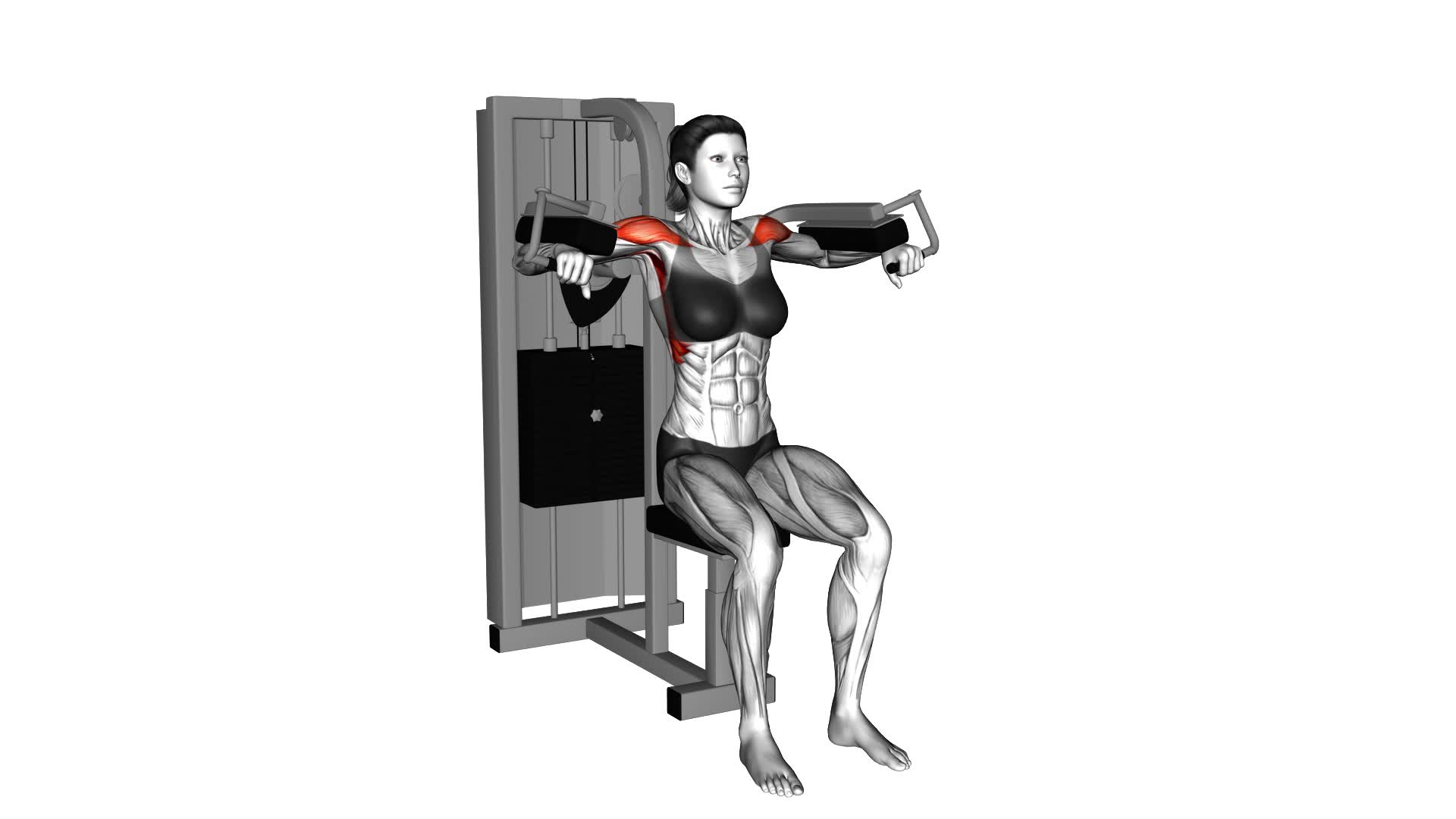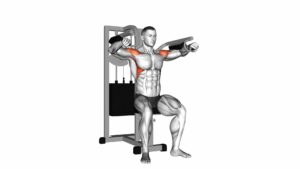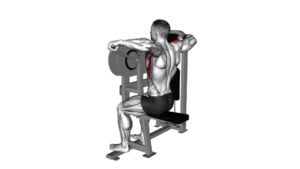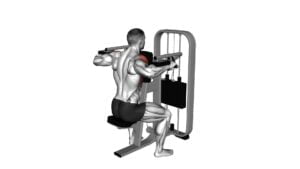Lever Lateral Raise (female) – Video Exercise Guide & Tips

Are you looking for a new exercise to target your shoulder muscles? Look no further than the lever lateral raise.
Watch This Exercise Video
In this video exercise guide, we'll show you the proper form and technique to maximize your results.
With variations to challenge yourself and tips to avoid common mistakes, you'll be on your way to a successful shoulder workout.
Get ready to tone and strengthen your shoulders with this effective exercise.
Let's get started!
Key Takeaways
- Improves shoulder strength and stability
- Enhances shoulder joint muscles, including deltoids, rotator cuff, and trapezius
- Helps prevent injuries during daily activities and sports
- Can be modified for beginners by starting with lighter weights and focusing on proper form
Benefits of Lever Lateral Raise
The lever lateral raise exercise offers numerous benefits for improving shoulder strength and stability. Shoulder stability is crucial for performing daily activities and sports, as it helps prevent injuries and allows for efficient movement. By incorporating the lever lateral raise into your workout routine, you can strengthen the muscles surrounding the shoulder joint, including the deltoids, rotator cuff, and trapezius muscles.
To modify the exercise for beginners, it's important to start with lighter weights and focus on proper form. Begin by sitting on a bench with your feet flat on the floor and your back straight against the backrest. Hold the lever handles with an overhand grip, palms facing down. Start with your arms by your sides and slowly raise them out to the sides until they're parallel to the ground. Avoid using momentum or swinging the arms. Pause briefly at the top of the movement and then slowly lower the arms back to the starting position.
Proper Form and Technique
To perform the lever lateral raise exercise with proper form and technique, position yourself on a bench with your feet flat on the floor and your back straight against the backrest. This exercise primarily targets the deltoid muscles in your shoulders, but it also engages the trapezius, triceps, and upper back muscles.
Here are three important tips to ensure you're using the correct form and technique for the lever lateral raise exercise:
- Grip the handles: Hold onto the handles of the lever machine with an overhand grip, keeping your palms facing down. This will help stabilize your body throughout the movement.
- Engage your core: Before starting the exercise, activate your core muscles by drawing your belly button towards your spine. This will provide stability and prevent any excessive arching of your back.
- Raise your arms out to the sides: Begin the movement by slowly lifting your arms out to the sides, keeping them parallel to the ground. Avoid any swinging or jerking motions, and focus on using your shoulder muscles to lift the weights.
Common misconceptions about the lever lateral raise exercise include using too much weight and allowing your back to round. Remember to start with a weight that challenges you but still allows you to maintain proper form. Keep your back straight throughout the exercise to avoid any strain or injury.
Variations to Challenge Yourself
To challenge yourself and further enhance the lever lateral raise exercise, you can incorporate different variations into your routine. These variations are designed to increase the difficulty of the exercise and help you progress to more advanced techniques.
One variation you can try is the single-arm lever lateral raise. Instead of using both arms simultaneously, lift one arm at a time while keeping the other arm extended. This variation not only challenges your shoulder muscles, but also engages your core for stability.
Another variation is the bent-over lever lateral raise. Instead of standing upright, hinge at the hips and lean forward while keeping your back straight. With your arms hanging straight down, lift them out to the sides until they're parallel to the ground. This variation targets the rear deltoids more intensely.
If you want to take it a step further, you can incorporate resistance bands or dumbbells into your lever lateral raise. These added weights will increase the difficulty and provide a greater challenge for your muscles.
Remember to start with a weight that's appropriate for your fitness level and gradually increase the resistance as you become stronger. Always maintain proper form and technique to prevent injuries and get the most out of your lever lateral raise variations.
Common Mistakes to Avoid
Avoid these 5 common mistakes when performing the lever lateral raise exercise to ensure you're getting the most out of your workout and preventing any potential injuries.
- Using too much weight: One of the most common mistakes people make is using weights that are too heavy. This can lead to improper form and put unnecessary strain on your shoulders. Start with lighter weights and gradually increase as you become more comfortable with the exercise.
- Swinging the body: Another mistake to avoid is swinging your body to generate momentum. This takes away from the effectiveness of the exercise and can put strain on your lower back. Keep your body still and use only your shoulders to lift the weights.
- Lifting the weights too high: While it may be tempting to lift the weights as high as possible, it's important to maintain proper form. Lifting the weights too high can cause unnecessary stress on your shoulder joints. Instead, focus on lifting the weights to shoulder level and maintaining control throughout the movement.
Tips for a Successful Workout
To ensure a successful workout, it's important to focus on proper form and technique while performing the lever lateral raise exercise. This exercise targets the deltoid muscles in your shoulders, helping to strengthen and tone them. However, to maximize your results, it's essential to stay motivated and manage your time effectively.
Firstly, maintaining workout motivation is crucial. Set clear goals for yourself and remind yourself of the reasons why you started exercising in the first place. Whether it's to improve your overall health, increase your strength, or enhance your physical appearance, keeping these goals in mind will help you stay focused and committed to your workouts.
Additionally, managing your time efficiently is key. Plan your workouts in advance and allocate specific time slots for exercise. This will help you prioritize your fitness routine and ensure that you have enough time to complete your workout without feeling rushed or stressed. Consider incorporating exercise into your daily schedule, whether it's early in the morning, during your lunch break, or in the evening.
Frequently Asked Questions
How Many Sets and Repetitions Should I Do for the Lever Lateral Raise Exercise?
For the lever lateral raise exercise, it's important to find the right balance between sets and repetitions. You want to challenge yourself, but not overdo it.
A good starting point is to aim for 3 sets of 10-12 repetitions. This will help build strength and endurance in your lateral deltoids.
As you progress, you can increase the number of sets or repetitions to continue challenging yourself.
Remember to always maintain proper form and technique throughout the exercise to maximize its effectiveness.
Can I Perform the Lever Lateral Raise Exercise Using Dumbbells Instead of the Lever Machine?
Yes, you can modify the lever lateral raise exercise by using dumbbells instead of the lever machine.
However, it's important to note that the lever machine provides certain benefits such as stability and controlled movement.
When using dumbbells, you'll need to focus on maintaining proper form and balance.
Dumbbells also offer a wider range of weight options, allowing you to progressively increase the resistance.
Is the Lever Lateral Raise Exercise Suitable for Beginners?
The lever lateral raise exercise can be suitable for beginners as long as proper form and progression options are followed.
To progress, you can increase the weight or repetitions gradually. It's important to avoid common mistakes, such as using momentum or lifting too heavy.
Focus on a controlled movement and engage your shoulder muscles throughout the exercise. Remember to start with lighter weights and gradually increase as you build strength and confidence.
Can I Incorporate the Lever Lateral Raise Exercise Into My Shoulder Workout Routine?
Incorporating the lever lateral raise exercise into your shoulder workout routine can be a great way to target and strengthen your shoulder muscles. This exercise specifically targets the lateral deltoids, helping to improve shoulder stability and enhance overall upper body strength.
To modify the exercise, you can adjust the weight and range of motion to suit your fitness level. It's important to maintain proper form and avoid any excessive swinging or jerking movements to prevent injury.
Are There Any Modifications or Alternatives to the Lever Lateral Raise Exercise for Individuals With Shoulder Injuries?
If you have shoulder injuries and are looking for modifications or alternatives to the lever lateral raise exercise, there are a few options you can consider.
Some modifications include using lighter weights or resistance bands, performing the exercise with a limited range of motion, or even substituting it with other shoulder exercises like front raises or bent-over lateral raises.
Remember to consult with a professional or physical therapist to ensure you're using proper form and not exacerbating your injury.
Conclusion
In conclusion, the lever lateral raise is a highly effective exercise for strengthening and toning the lateral muscles of the shoulders.
By maintaining proper form and technique, you can maximize the benefits of this exercise and avoid common mistakes.
Additionally, incorporating variations into your workout routine can provide a greater challenge and further enhance your results.
Remember to always listen to your body and consult with a fitness professional if you have any concerns or questions.
Keep up the great work and enjoy a successful workout!

Author
Years ago, the spark of my life’s passion ignited in my mind the moment I stepped into the local gym for the first time. The inaugural bead of perspiration, the initial endeavor, the very first surge of endorphins, and a sense of pride that washed over me post-workout marked the beginning of my deep-seated interest in strength sports, fitness, and sports nutrition. This very curiosity blossomed rapidly into a profound fascination, propelling me to earn a Master’s degree in Physical Education from the Academy of Physical Education in Krakow, followed by a Sports Manager diploma from the Jagiellonian University. My journey of growth led me to gain more specialized qualifications, such as being a certified personal trainer with a focus on sports dietetics, a lifeguard, and an instructor for wellness and corrective gymnastics. Theoretical knowledge paired seamlessly with practical experience, reinforcing my belief that the transformation of individuals under my guidance was also a reflection of my personal growth. This belief holds true even today. Each day, I strive to push the boundaries and explore new realms. These realms gently elevate me to greater heights. The unique combination of passion for my field and the continuous quest for growth fuels my drive to break new ground.







